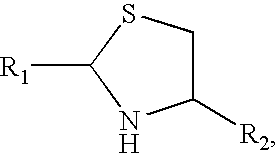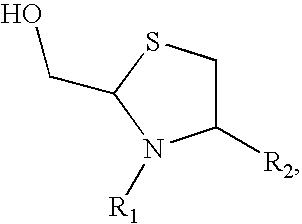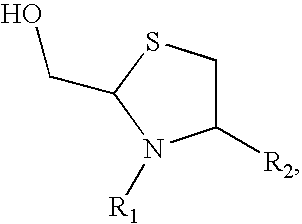Methods for Site-Specific Pegylation
a site-specific, pegylation technology, applied in the direction of peptides/protein ingredients, immunoglobulins, peptides, etc., can solve the problems of short in vivo circulating half-life, short circulating half-life, and lower efficacy, and achieves less content variation, high site selection, and easy characterization, purification and manufacture
- Summary
- Abstract
- Description
- Claims
- Application Information
AI Technical Summary
Benefits of technology
Problems solved by technology
Method used
Image
Examples
example 2
Preparation of mPEG-Tmc-Lvs-Phe-NH2 (SEQ ID NO:2)
[0080]mPEG herein has the structure of CH3—O—(CH2CH2O)n—(CH2)2—, wherein n is a positive integer.
[0081]The peptide product of Example 1 (0.5 mg 1.22 micromole) was dissolved in 1.0 mL of a pH 4 buffer (20 mmolar NaOAc, 150 mmolar NaCl, and 1 mmolar EDTA). To the resulting solution was added mPEG-aldehyde (1.5 equivalents, the average molecular weight is 31378 Da, NOF Corp., Tokyo, Japan). The reaction was approximately 90% complete after 27 hours at room temperature based on the analysis done by using a reverse-phase analytical HPLC system (Vydac C18 5μ peptide / protein column, 4.6×250 mm). The reaction mixture was applied to a 5 mL Zeba™ desalt spin column (Pierce Biotechnology, Rockford, Ill.). A white foam was obtained after lyophilization (36.7 mg).
example 3
Preparation of H-NMeCys(Prd-PEG)-Lys-Phe-NH2 (SEQ ID NO:3)
[0082]
[0083]The peptide product of Example 1 (0.5 mg 1.22 micromole) was dissolved in 1.0 mL of a pH 7 buffer (20 mmolar NaOAc). To the resulting solution was added α-(3-(3-maleimido-1-oxopropyl)amino)propyl-o-methoxy-polyoxyethlene (1.5 equivalents, the average molecular weight is 11962 Da, NOF Corp., Tokyo, Japan) and 2 equivalents of Tris(2-carboxyethyl)phosphine hydrochloride (TCEP). The reaction was complete after one hour at room temperature based on the analysis done by using a reverse-phase analytical HPLC system (Vydac C18 5μ peptide / protein column, 4.6×250 mm). The reaction mixture was applied to a 5 mL Zeba™ desalt spin column (Pierce Biotechnology, Rockford, Ill.). A white foam was obtained after lyophilization (5.1 mg). The product was further purified on High Trap™ SPXL cation exchange column (GE Healthcare, Piscataway, N.J.). The molecular weight distribution of the purified product was determined by using MALD...
example 4
Preparation of H-Cys-Lys-Phe-NH2 (SEQ ID NO:4)
[0084]
[0085]The title peptide was synthesized on a Liberty™ model microwave peptide synthesizer (CEM Corp., Matthews, N.C.) using Rink amide MBHA resin (347 mg 0.25 mmole) (Novabiochem, San Diego, Calif.). The amino acids Fmoc-Phe-OH, Fmoc Lys(Boc)-OH, and Fmoc-Cys(Trt)-OH (Novabiochem, San Diego, Calif.) were used in four fold excess using HBTU activation and each coupling was repeated.
[0086]The peptide was cleaved from the resin by shaking resin with 8% trispropylsilane / trifluoroacetic acid (TFA) with 1% dithiothreitol (10 mL) for three hours. The resin was filtered and washed with DCM (5 mL). The filtrates were combined and concentrated to 3 mL. Diethyl ether (35 mL) was added to precipitate the peptide. The precipitated peptide was collected after centrifuging. The pellet was dissolved in water and acetonitrile and then was lyophilized.
[0087]The resulting crude product was purified on a reverse phase HPLC system (Luna 5 micron C8 (2)...
PUM
| Property | Measurement | Unit |
|---|---|---|
| Mass | aaaaa | aaaaa |
| Mass | aaaaa | aaaaa |
| Mass | aaaaa | aaaaa |
Abstract
Description
Claims
Application Information
 Login to View More
Login to View More - R&D
- Intellectual Property
- Life Sciences
- Materials
- Tech Scout
- Unparalleled Data Quality
- Higher Quality Content
- 60% Fewer Hallucinations
Browse by: Latest US Patents, China's latest patents, Technical Efficacy Thesaurus, Application Domain, Technology Topic, Popular Technical Reports.
© 2025 PatSnap. All rights reserved.Legal|Privacy policy|Modern Slavery Act Transparency Statement|Sitemap|About US| Contact US: help@patsnap.com



